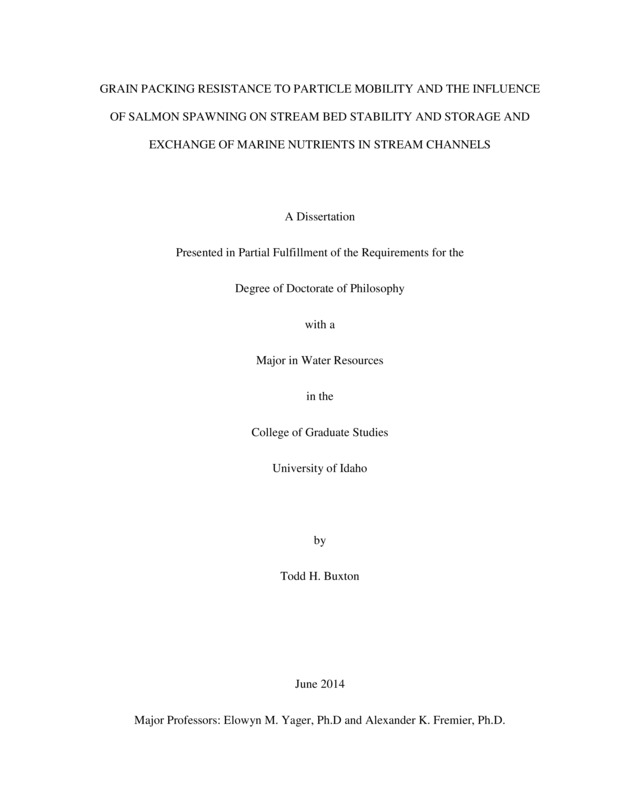GRAIN PACKING RESISTANCE TO PARTICLE MOBILITY AND THE INFLUENCE OF SALMON SPAWNING ON STREAM BED STABILITY, AND STORAGE AND EXHANGE OF MARINE DERIVED NUTRIENTS IN STREAM CHANNELS
Buxton, Todd. (2014). GRAIN PACKING RESISTANCE TO PARTICLE MOBILITY AND THE INFLUENCE OF SALMON SPAWNING ON STREAM BED STABILITY, AND STORAGE AND EXHANGE OF MARINE DERIVED NUTRIENTS IN STREAM CHANNELS. Theses and Dissertations Collection, University of Idaho Library Digital Collections. https://www.lib.uidaho.edu/digital/etd/items/buxton_idaho_0089e_10168.html
- Title:
- GRAIN PACKING RESISTANCE TO PARTICLE MOBILITY AND THE INFLUENCE OF SALMON SPAWNING ON STREAM BED STABILITY, AND STORAGE AND EXHANGE OF MARINE DERIVED NUTRIENTS IN STREAM CHANNELS
- Author:
- Buxton, Todd
- Date:
- 2014
- Keywords:
- Grain-scale processes Hyporheic flow Salmon spawning Sediment stability
- Program:
- Water Resources
- Subject Category:
- Geomorphology; Fisheries and aquatic sciences; Hydrologic sciences
- Abstract:
-
Pacific salmon (Oncorhynchus spp.) influence the structure and productivity of stream ecosystems by altering the stability of river beds during spawning and delivering marine derived nutrients (MDN) to watersheds. Although much has been learned about the physical and ecological roles of salmon in streams, it remains unclear how spawning modifies grain packing, streambed stability, and the residence time and exchange of MDN in streambeds.
A female salmon modifies streambeds by using rapid undulations of her tail to build a nest (redd) for spawning. During redd construction, streambed sediments are mixed, fines are winnowed, and grain packing is loosened as the female moves sediment into a dune-like mound (tailspill) while digging a pit in which to deposit her eggs. This process was simulated on water-worked beds composed of mixed-grain sizes in a laboratory flume, and measurements on simulated redds and bed surfaces undisturbed by spawning were used to quantify grain packing resistance to particle motion and the relative stability of redds and unspawned beds.
Grain packing resistance was determined as the difference between the total resistance to granular motion (measured with a load cell) and that due to pocket resistance (measured with a tilt board) on the flat portion of simulated redds and planar unspawned beds. Packing was the primary form of resistance to grain motion, exceeding pocket resistance by as much as 80%. Packing also increased calculations of critical bed shear stress and Shields stress and decreased the exponent in a grain hiding function, promoting conditions that tend toward equal mobility.
Experiments determining packing resistance were expanded to the entire redd structure, and the stability of redds and unspawned beds was assessed with calculations of critical shear stress, estimates of boundary shear stress, visual measurements of sediment mobility, and bedload transport measurements. Findings indicate packing resistance to grain motion was up to 39% lower on redds, which resulted in lower critical shear stress on spawned surfaces. This in combination with flow convergence elevating boundary shear stress on the tailspill led to incipient motion being observed at a bed-average shear stress that was 22% lower on a redd. Visual observations were confirmed as the average mass transport rate of sediment per unit bed area was nearly 5 times higher on a redd than unspawned bed. The finding that redds are unstable compared to unspawned beds suggests a linkage between salmon spawning and streambed mobility that may have implications for the formation and maintenance of fish habitats in salmon-bearing streams.
The residence time of MDN delivered to streams by salmon influences stream productivity since biochemical processing requires a certain amount of time to occur. Salmon spawning winnows fine sediment and loosens packing, which increase sediment porosity and hydraulic conductivity. This combined with topographically-forced pressure variations pumping water through redds may elevate hyporheic exchange and decrease the residence time (=hyporheic volume/hyporheic exchange flux) of MDN in the bed. An evaluation of these influences indicates the residency of MDN decreases with increased proportions of a planar bed surface occupied by redds, from 5.79 h on an unspawned bed to 0.03 h for a mass spawned bed (1.0 spawning). Shorter residence times with increased spawning results from hyporheic exchange rising over four orders of magnitude with spawning while hyporheic volume increased less than an order of magnitude. High hyporheic exchange associated with redds increases nutrient storage compared to the exchange that occurs in unspawned beds, suggesting a positive feedback between spawning activity and nutrient uptake that may promote salmon reproduction and future returns of adult salmon.
- Description:
- doctoral, Ph.D., Water Resources -- University of Idaho - College of Graduate Studies, 2014
- Major Professor:
- Fremier, Alexander K.; Yager, Elowyn M.
- Committee:
- Buffington, John M.; Hassan, Marwan A.
- Defense Date:
- 2014
- Identifier:
- Buxton_idaho_0089E_10168
- Type:
- Text
- Format Original:
- Format:
- application/pdf
- Rights:
- In Copyright - Educational Use Permitted. For more information, please contact University of Idaho Library Special Collections and Archives Department at libspec@uidaho.edu.
- Standardized Rights:
- http://rightsstatements.org/vocab/InC-EDU/1.0/

